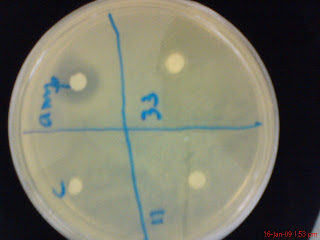This experiment is unlike the previous experiment, it takes about four days to complete.
Title of experiment: Antibiotic Sensitivity (Kirby-Bauer Test)
Objective: To determine the presence of antibiotic sensitivity in the MB.
Materials-
unsterilized: 7 pathogen samples, 14 petri dishes (with marine nutrient agar), parafilm, hockey stick, pipette, ampicillin
Sterilized: centrifuge tubes, tips, disk filter paper in glass petri dish, nutrient broth/agar in schott bottle, scraper, flasks
Method-
Day 1
1. Prepare all cell suspension.
2. Prepare 7 centrifuge tubes flled with 5ml of nutrient broth.
3. Inoculate the pathogens into each nutrient broth.
4. shake in incubator 30C, 200 rpm, 24 hours.
For marine bacteria suspension (grow again the bacteria of 11 and 33 from the flasks into new flasks):
1. Inoculate the bacteria into 5ml marine nutrient broth.
2. Shake in incubator 30C, 200 rpm, 24 hours.
Day 2
1. Clean the laminar flow and get it ready for the next experiment.
2. Materials needed are 14 petri dishes and labeled with the names of the seven pathogens with two petri dishes for each pathogen and also divided the petri dishes into four compartments.
3. First, spread the petri dishes with pathogens on the agar surfaces by using hockey stick.
4. After that, put the disk paper into four different compartments, with each different solution for each compartment- C is for control, Amp is for ampicillin, 11 is for bacteria 11 and 33 is for bacteria 33. Do the same for the rest of the petri dishes.
5. Store the petri dishes in fridge 2-4 C for 24 hours (pre-diffusion techniques)
Day 3
Take the petri dishes out and store in ambient temperature.
Day 4
Observe result
Result:
The seven pathogens are:
1. Strep. Feacalis
2. Macro Luteus
3. proteus Ugeris
4. Entero Unerogeres
5. Strep yerus
6. E. Coli
7. Se. macro
The antibiotic sensitivity of the bacteria will be based upon the presence of halogen zone around the disk filter paper in the bacteria's compartment. In other words, if the bacteria has antibiotic sensitivity, it should have the same result as the ampicillin.
The pictures above are in the sequence of the list of pathogens above. The result, as you can seen in the pictures, most of it has been contaminated. There is only one bacteria that shows antibiotic sensitivity and that is Bacteria 33 to pathogen Se. macro. However the result is not so clear indicated as it might also be the result of contamination.
Conclusion: There is only one bacteria that shows antibiotic sensitivity and that is Bacteria 33 to pathogen Se. macro. However the result is not so clear indicated as it might also be the result of contamination.
Thursday, February 19, 2009
January 13-16
Posted by SunSeT at 10:01 AM
Subscribe to:
Post Comments (Atom)







0 comments:
Post a Comment